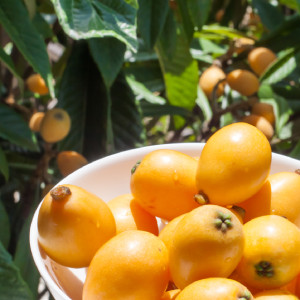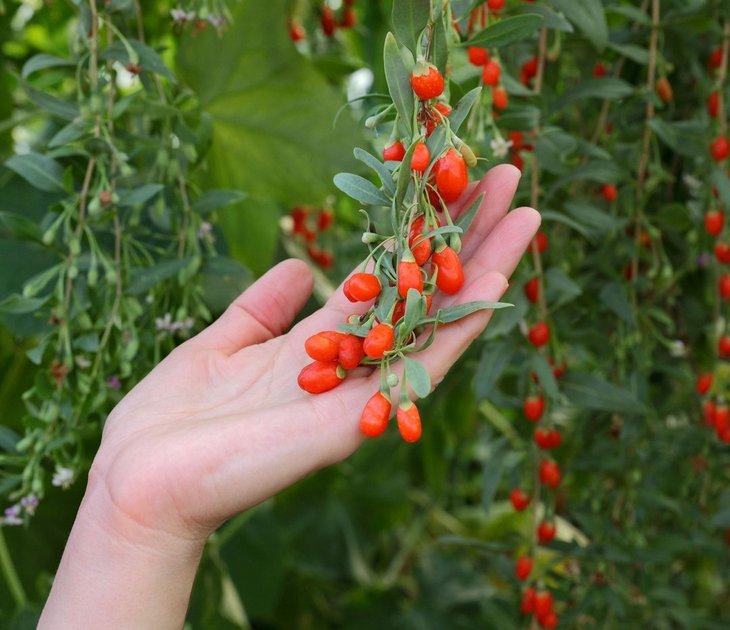Exploring Fresh Local Food-Herbs
Whether your philosophy regarding food is “Eat to Live” or “Live to Eat”, we can all agree that food is important to our lifelong health and well-being. In traditional Chinese medicine (TCM), food is the source of post-natal Qi, should be eaten in accordance with the season and one’s constitution, and can help correct imbalances. Chinese dietary therapy emphasizes the concept of Yao Shi Tong Yuan 藥食同源 “medicine and food have the same origin”. Ancient herbalists applied the traditional Chinese medicine theory of "four natures" and "five flavors" to all animals, plants, minerals, etc. and determined that basically anything could be medicine, food, or poison depending upon the dosage. At Mayway, our 10-volume Chinese Materia Medica has nearly 9,000 entries! In TCM medicine and food are relative terms: medicine and food can be interchangeable, with “food” generally considered to have less side effects and toxicity.
The idea of Yao Shi Tong Yuan is supported in many ancient texts, including in the Xiuwu Xun chapter of the Huainanzi《淮南子·修務訓》which mentions: "Shen Nong tasted the taste of all kinds of herbs, and the sweetness and bitterness of water springs, so that the people knew what to avoid. At this time, seventy poisons were encountered in one day." The Huangdi Neijing Taisu 《黃帝內經太素》 mentions: "Eating on an empty stomach is food, and patients eating it is medicine,” which points to consumptive intention. The Su Wen’s Zang Qi Fa Shilun 《素問·藏氣法時論》 Seasonal Organ Pathology chapter states: “Toxic drugs attack the evil. The five grains provide nourishment. The five fruits provide support. The five domestic animals provide enrichment. The five vegetables provide filling. When they are consumed in [appropriate] combinations of their Qi and flavors, they serve to supplement the Essence and to enrich the Qi.“
Today, most Chinese herbs we ingest are meant to be clinically therapeutic, but there are still many popular food-herbs in Chinese culture and cooking. The Chinese government has a list of food-herbs which can legally be sold as either, and in fact has issued 3 separate lists: items that are both food and medicine, items that can be used in health food, and prohibited Items in health food. Here in the U.S. Chinese herbs are categorized by the FDA as dietary supplements, which are technically considered to be food. This is wonderful because there aren’t sales restrictions and food-herbs are readily available. Dried food-herbs like the ones in our Mayway Recipes section are easy to come by, but in Chinatowns and larger Asian food markets, you can sometimes find them fresh depending upon the season. Here in the San Francisco Bay Area, they include:

Bai He/Lily bulb
There is basically no difference in therapeutic effect between fresh and dried lily bulbs. Bai he alleviates cough and phlegm and moistens the Lungs. Delicately sweet and crisp in stir-frys, fresh Bai he is not only prized for its taste and texture but is known to be high in Vitamin E so is a good antioxidant, promotes cell regeneration, and improves immunity. Fresh Bai he may be found in the refrigerated section in vacuum sealed containers.
Niu Bang Gen/Burdock Root
In TCM Niu bang gen is considered bitter and slightly sweet in taste, and cool in nature, entering the Heart and Lung meridians and functioning to expel Wind-Heat and resolve inflammation. It is also a well-established western dietary supplement with many purported disease-fighting benefits abundantly enumerated on the internet. The fresh roots are understood to have the same benefits and are used in almost every culinary way: stir-frys, soups, congee, pickled, honeyed, steamed, steeped as tea, and in salads, all with cooking videos available on YouTube and recipes shared on social media, especially within the Chinese community.
Burdock Root also naturally contains lots of soluble fiber, and its mild taste (after soaking, blanching, or cooking to lower the natural astringency) makes it a favorite for helping regulate digestion and bowel irregularity. Chock full of nutrients, its carotene level is 150 times higher than carrots, making it a great addition to most any dish!
Shan Yao
“Iron Rod” Shan yao (named for its thick, super-straight appearance) is popular and what we tend to find available fresh. Its flesh is very white in color and the grain is very fine. Steamed and used in stir-fry dishes, it has a floury texture and is sweeter in taste than dried. Fresh Shan yao purportedly has a better effect on nourishing Yin and has more effects on the Lungs and Kidneys, while dried Shan Yao more strongly nourishes the Spleen. Both strengthen the Spleen, nourish the Lungs and benefit the Essence.
Lian Ou/Lotus Root
Fresh Lotus roots are eaten to Clear Heat, Cool the Blood, and Generate Fluids, especially if squeezed for juice or eaten raw in salad. Cooked fresh lotus root is sweet and warm in nature, can invigorate the Spleen and appetite, benefit Blood and invigorate the Heart, mainly nourishing the Five Organs.

Besides containing lots of good vitamins and phytonutrients, lotus roots are crunch and delicious and also contain lots of fiber!
Hong Zao/Red dates
As the saying goes, "Eat three Hong zao a day, and you will not look old for a lifetime." Hong zao is warm in nature and sweet in taste. It invigorates the Spleen, nourishes the Middle, tonifies Qi and Blood and generates Fluids.
Fresh Hong zao is sweet and delicious, provides a good amount of fiber and is richer in vitamins than dried, but eating too many will hinder digestion so eat them sparingly. Although the vitamin content of dried Hong zao is decreased, the iron content is increased and its nutrition is easier to absorb, making it more suitable for diet therapy.
Drink a tea made from sliced, pitted, dried red dates steeped in hot water to nourish the Liver and detoxify. Experiments have shown that drinking red date tea every day for one week can increase human serum protein, thereby protecting our liver and assisting natural detoxification.

They tend to be grown in California’s Central Valley.
Pi pa/Loquat
Although the leaves (Pi pa ye) are what is usually used in TCM, Loquat fruit is actually stronger in moistening the Lungs, stopping cough, and alleviating thirst. The fruit is just not practical to use in medicines like cough syrups because unlike the leaves, they have a relatively short growing season, bruise and rot easily, and are very expensive. Pi pa has a delicate sweet flavor and almost melts in the mouth.
At the time of this writing, here in the East San Francisco Bay Area, you will find luscious fruit ripening in many neighborhoods. Given their delicateness, you will rarely find them in shops but may find them sold on the street in Chinatown by elderly peddlers who have harvested them from their own (or neighbors’) trees. Large, perfect specimens can cost up to $20 a pound!
Gou Qi Zi/Goji Berry

Fresh Gou qi zi is not found commercially, even in China. The skin is extremely delicate, and the fruit will quickly rot and mold once the skin is broken, so usually only the communities that harvest it will enjoy it fresh. There are six identified types of Gou qi zi grown in various parts of China, and while all are nutritious and available commercially in China dried, only the famous Ningxia variety is allowed to be used as medicine in the Chinese Pharmacopoeia. Comparatively, the dried Ningxia variety is thin, spindly, and only mildly sweet with a slightly bitter aftertaste. As the only accepted medicinal variety, they are also much more expensive. The Goji Berry craze seems to have subsided a bit, but the takeaway here is that although all varieties of Gou qi zi have lots of good vitamins and antioxidants, don’t assume that the plump, sweet, dried Gou qi zi from Costco, or in that smoothie or snack bar are particularly therapeutic. For fresh ones, try growing the Ningxia variety using our Plum Flower® Gou qi zi in a large patio planter at home. We have two small bushes growing right now at our office!
Fo Shou/Buddha’s Hand

An almost-ethereally fragrant, fantastic-looking Citrus, fresh Fo shou is a piece of fruit art on the level of Dragon fruit, Rambutan, and Durian. Its shape with long tapering “fingers” almost in a mudra pose is what gives it its name. In TCM, it is considered spicy, bitter, and sour in taste, and warm in nature. It enters the Liver, Spleen, Stomach, and Lung meridians, functioning to soothe the Liver and regulate Qi, harmonize the Stomach, dry Dampness and resolve Phlegm. The fresh fruit when ripe is seemingly made up of just a bright yellow rind and thick white mesocarp. It can be sliced thinly and steeped in hot water for an amazingly fragrant tea with all the health benefits intact or shredded for baking and candying. The rind also makes a fantastic zest, and the crisp mesocarp eaten raw and added to salads. There are stir-fry recipes online, but Buddha’s Hands are very, very expensive in the U.S. (I once paid $10 for one!) so most people use it steeped in tea. Some of us here at Mayway are trying to grow them at home---I harvested 3 last year from my chest-high tree!
Growing up in Chinatown and with herbs basically being part of our DNA, we’ve been eating food-herbs our entire lives, and especially enjoy sharing this aspect of our culture with you all. Those who follow us on social media will sometimes see a post of our Mom tending her Ai ye or her Gou qi zi bushes, and videos of us cooking with food-herbs. We’d love to hear your herb-growing and TCM cooking stories, so feel free to share them with us on social media. If you need inspiration, check out our Seasonal Recipes section on using fresh and dried food-herbs. Have a great summer and happy eating!
About the Author
References
- http://www.chinaknowledge.de/Literature/Daoists/huainanzi.html
- https://zh.wikipedia.org/zh-cn/%E9%A3%9F%E8%97%A5%E5%90%8C%E6%BA%90
- https://www.sohu.com/a/161898009_99914421
- http://www.biblio.nhat-nam.ru/Huang_Di_Nei_Jing_Su_Wen-Unschuld-Tessenow-1-2.pdf
- https://www.edh.tw/article/19530
- https://www.edh.tw/article/182
- http://www.agri.cn/V20/SHXX/jksp/201606/t20160614_5169874.htm
- https://www.sohu.com/a/308974508_120009574


